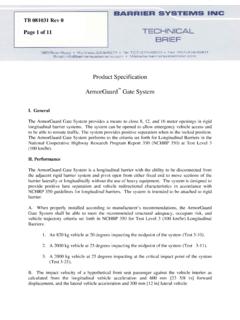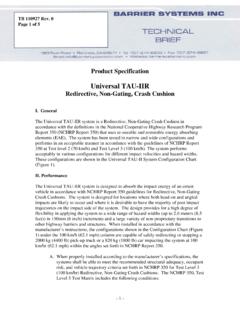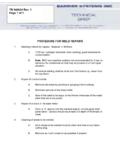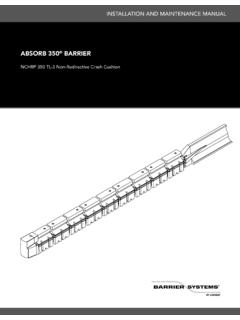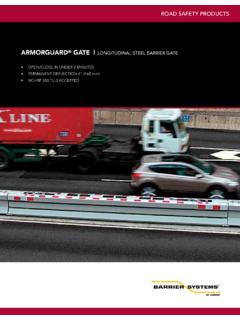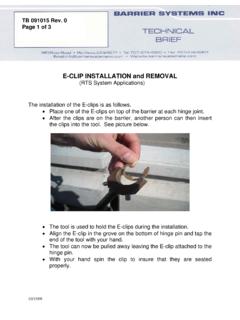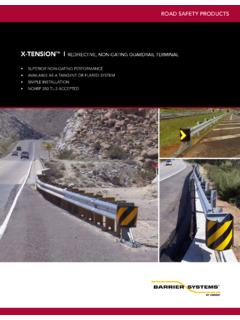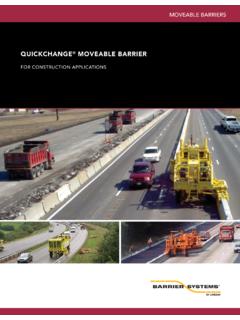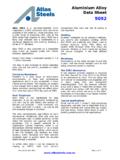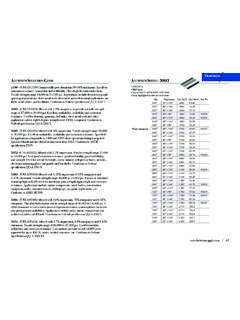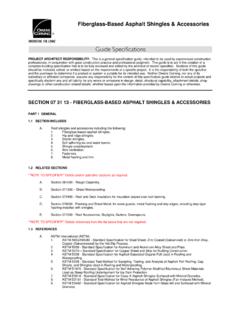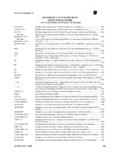Transcription of TB 000611 Rev. 1 - ABSORB TL-3 Perm or Portable
1 TB 000611 Rev 1. Page 2 Rev. TB 000611 of 81. Page 1 of 8. Product specification ABSORB 350TM TL-3. Non-Redirective, Gating, Crash Cushion Applied to Permanent and Portable Concrete Barrier I. General The ABSORB 350TM TL-3 System is a Non-Redirective, Gating, Crash Cushion in accordance with the definitions in the National Cooperative Highway Research Program Report 350 (NCHRP 350). The system shall be tested and perform in an acceptable manner in accordance with the guidelines of NCHRP 350 at Test Level 3 (100 km/h). II. Performance The ABSORB 350 is designed to ABSORB the impact energy of an errant vehicle in accordance with NCHRP 350 guidelines for Non-Redirective, Gating, Crash Cushions. The system is designed to be attached to Permanent Concrete Barrier and Portable Concrete Barrier with section lengths of at least meters (10 feet).
2 When attached in accordance with the manufacturers instructions, the ABSORB 350 system is capable of safely stopping a 2000 kg (4400 pound) pickup truck impacting the system at 100 km/h ( mph) and 0 degrees and an 820 kg (1800 pound) compact vehicle impacting the system at 100 km/h ( mph), 0 degrees and with an offset of the vehicle and system centerlines of one-fourth the vehicle width. A. When properly installed according to the manufacturer's recommendations the ABSORB 350 system shall be fully tested to and meet the recommended structural adequacy, occupant risk, and vehicle trajectory criteria set forth in NCHRP 350 for Test Level 3 Non-Redirective, Gating Crash Cushions (NCHRP 350 TL-3): 1. Impact at 0 degrees at w/4 offset (centerline of vehicle offset 1/4 width of vehicle from centerline of system) at 100 km/h with an 820C vehicle.
3 This is Test 3-40 of NCHRP 35. TB 000611 Rev 1. Page 2 of 8. 2. Impact at 0 degrees into center nose of device (0 offset from centerline of vehicle) at 100 km/h with a 2000P vehicle. This is Test 3-41 of NCHRP 350. 3. Impact at 15 degrees into center nose of device (0 offset from centerline of vehicle) at 100 km/h with an 820C vehicle unless the Federal Highway Administration, due to acceptable performance in test 3-40, waives this test. This is Test 3-42 of NCHRP 350. 4. Impact at 15 degrees into center nose of device (0 offset from centerline of vehicle) at 100 km/h with a 2000P vehicle. This is Test 3-43 of NCHRP 350. 5. Impact at 20 degrees along the side of the unit (with the centerline of the vehicle aligned with the centerline of the attachment of the barrier and the ABSORB 350 ) at 100 km/h with a 2000P vehicle.
4 This is Test 3-44 of NCHRP. 350 as modified by the Federal Highway Administration. B. The impact velocity of a hypothetical front seat passenger against the vehicle interior as calculated from the longitudinal vehicle acceleration and 600 mm [23 5/8 in] forward displacement, and the lateral vehicle acceleration and 300 mm [1 ft] lateral displacement shall be less than 12 m/s ( ft/s] and the highest 10 ms average vehicle acceleration in the longitudinal and lateral directions subsequent to the instant of hypothetical occupant impact shall be less than 20 g's in NCHRP 350 tests 3-40, 41, 42 and 43. For TL-3 impacts detached debris shall not show potential for penetrating the vehicle occupant compartment or presenting a hazard to other traffic, pedestrians, or workers in a work zone. The vehicle shall remain upright during and after the collision although moderate roll, pitch and yaw may occur.)
5 III. Description of System A. The ABSORB 350 system shall be made up of the following components and the system shall be fabricated from materials conforming to the following specifications: 1. ABSORB 350 Energy Absorbing Element Each element of the system shall be composed of a plastic container, steel side bars, end plate/ hinge assemblies, an evaporation prevention cap with tether and appropriate fasteners. The overall dimensions of the assembled element are 610 mm (24. inches) wide, 812 mm (32 inches) tall and 1000 mm (39 1/2 inches) long, as shown in the attached drawing (B000524). Each element of the system shall weigh approximately 50 kg (110 pounds) when empty and 325 kg (717. pounds) when filled. The first element of the assembled system should always be empty of fluid with the evaporation prevention cap installed.
6 All other elements of the system should be filled with fluid in accordance with the installation instructions and the evaporation prevention cap shall be securely installed. All elements shall be attached in accordance with the installation instructions and drawings supplied by the manufacturer. TB 000611 Rev 1. Page 3 of 8. a. The plastic elements shall be molded from Linear Low Density Polyethylene. b. All steel sidebars, end plate/hinge assemblies shall be fabricated from mild steel in conformance with ASTM A-36 specifications. c. The evaporation prevention cap shall be molded from low density polyethylene 2. ABSORB 350 Nose Piece Each ABSORB 350 system shall contain one Nose Piece at the front of the system. The Nose Piece is approximately 620. mm (24 3/8inches) wide, 825mm (32 1/2inches) tall and 610mm (24 inches).
7 Long, as shown in the attached drawing (B000526). The Nose Piece shall weigh approximately 60 kg (132 pounds) and shall be attached to the first Energy Absorbing Element in accordance with the installation instructions and drawings supplied by the manufacturer. a. The Nose Piece shall be fabricated from mild steel in conformance with ASTM A-36. b. The Nose Piece shall also have an aluminum skin on the front portion to provide an aesthetic cover and a place for attaching traffic control signage, if needed. This skin shall be fabricated from 5052 H32 in conformance with ASTM B209 and shall be attached to the steel portion of the Nose Piece with adhesives and pop rivets. 3. ABSORB 350 Transition Hardware for PCB The transition configuration is as shown in the attached drawing B000608. a. PCB Transition Hardware is fabricated from mild steel in conformance with ASTM A-36 as shown in the attached drawing (B000531).
8 The steel components shall weigh approximately 80 kg (176 pounds). B. Attachment of the ABSORB 350 system to PCB systems shall require nine (9). Energy Absorbing Elements. Assembly should be in compliance with the manufactures drawings and written instructions. C. The ABSORB 350 system shall be able to be refurbished after a NCHRP 350 type impact in less than 1 hour with two people, an adequate fluid supply and refurbishment materials. D. The ABSORB 350 system shall not require attachment to a foundation. Attachment to the PCB system will require attachment in accordance with the manufacturer's drawings and instructions. TB 000611 Rev 1. Page 4 of 8. E. The ABSORB 350 system shall be assembled and filled with fluid in accordance with the manufacturers instructions. If there is a possibility that the fluid in the system could freeze due to low temperatures, proper antifreeze agents should be used in accordance with local standards and environmental regulations.
9 IV. Application of Safety Appurtenances Highway safety appurtenances should be applied to hazardous sites in accordance with the guidelines and recommendations in the American Association of State Highway Transportation Officials (AASHTO), Roadside Design Guide, 1989, and other Federal Highway Administration and State Department of Transportation requirements. Placement and use of the ABSORB 350 system should comply with these specifications and guidelines. TB 000611 Rev 1. Page 5 of 8. TB 000611 Rev 1. Page 6 of 8. TB 000611 Rev 1. Page 7 of 8. TB 000611 Rev 1. Page 8 of 8.
